This is a follow-up from last week’s post titled Caryatids: Images of the Queen Archetype. Deborah wondered what the Caryatids on the Maiden Porch of the Greek temple on the Acropolis in Athens called the Erechtheum (or Erechtheion) might have been carrying in their hands. So I’ve just done some digging through my photographs taken on a trip to Greece nine years ago and found these pictures. I love that this one shows the Maiden Porch amidst the iconic blues and whites of the Greek islands.

Here’s a brief summary of the history of the temple:
The Erechtheion, designed by the architect Mnesikles, was a complex building constructed in the last twenty years of the 5th century BC. It replaced the “Archaios Neos” (Ancient Temple) of Athena Polias, part of which had been destroyed by the Persians sixty years earlier. The new temple was divided into two chambers: an eastern room dedicated to Athena, which held the goddess’ wooden cult statue; and a lower western room that accommodated shrines of Poseidon-Erechtheus, Hephaistos and Boutes, the brother of Erechtheus.
The Erechtheion’s unusual form resulted from the architect’s need to accommodate all of these cults within one building, while also adapting its structure to the site’s uneven ground. Moreover, the complex had to incorporate the sacred symbols of Poseidon’s struggle with Athena for hegemony over Αthens: the olive tree given to the city by Athena; the marks in the bedrock left by Poseidon’s trident; and the spring of salty water that arose after he smote the rock.
The Erechtheion’s best-known feature may be its south porch, whose roof, instead of being supported on columns, rested on the heads of six Korai statues – the famous Karyatids. Five of them are now in the Acropolis Museum, displayed on a special balcony and visible from all sides, while the position of the sixth Kore, still held in the British Museum, has been left empty. Source
The World History Encyclopedia writes this:
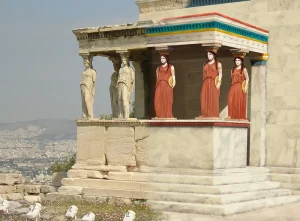
The real stars of the Erechtheion are without doubt the Caryatids or korai as they were known to the ancient Greeks. The finely-sculptured figures are not unique to the building as other examples exist in the architecture of the Archaic period, particularly in Treasury buildings at sacred sites such as Delphi and Olympia. Their clinging Doric clothes (peplosand himation) and intricately plaited hair are rendered in fine detail. Their bold stance and the firm set of the straight standing leg give the impression that the task of bearing the weight of the porch entablature and roof is effortless. Rather cleverly, the straight leg also creates folds in their clothing remarkably similar to the flutes on an ordinary Ionic column. Originally, the figures raised slightly their robe with one hand and held shallow libation vessels (phialai) with the other. This may have been in reference to the fact that it was believed that the tomb of the mythical King Kekrops lay under the building, and perhaps the libations poured by the Caryatids replicate the practice of pouring libations into the ground as an offering to the dead. The Caryatids now on the acropolis are exact copies; five of the originals reside in the Acropolis Museum of Athens and the other is in the British Museum, London.
Shallow libation vessels? I guess that’s one possibility. Personally, I’m not a fan of the above painted rendition, though.
The leader of our group was the prolific author, lecturer, independent scholar, mythologist, screenwriter, and documentary filmmaker, Phil Cousineau. I especially love his book, The Art of Pilgrimage. After beginning our tour in Athens we visited several other places, including the town of Heraklion in Crete. I especially enjoyed the spectacular Heraklion Archaeological Museum which contains an assortment of relics from ancient Greece.
Although the Athenian, Mycenaean, and Minoan civilizations would have worshiped different Gods and Goddesses in different eras and used different styles, materials, and motifs, the objects pictured below are nonetheless representative of the kinds of artifacts that were in common use throughout the lands bordering the Aegean Sea.
Since the Erechtheum is believed to have been a temple to Athena and Poseidon, archaeologists assume the Caryatids would have carried objects for religious rituals: decorated amphoras, bowls, boxes, and other containers for wine, water, precious oils, fruits, and spices, plus small votives, statuettes of the god and goddess, and carvings or sculptures of religious symbols. Perhaps they even carried scrolls, as Deborah suggested after last week’s post.
Following are some pictures I took of the kinds of things the Caryatids might have carried. Enjoy.
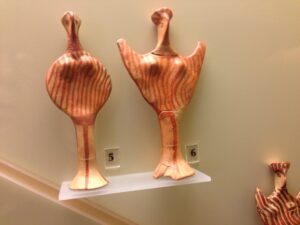
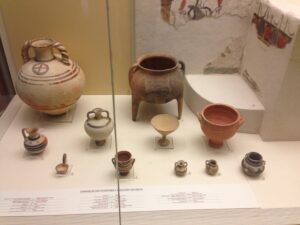
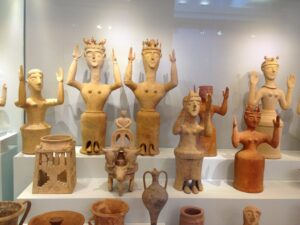
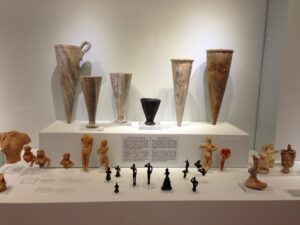
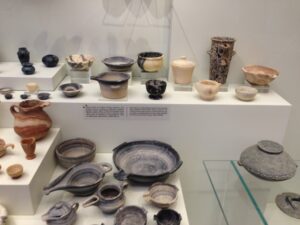
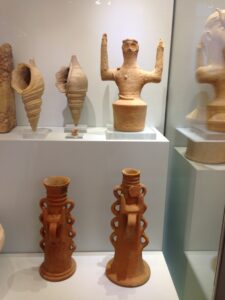
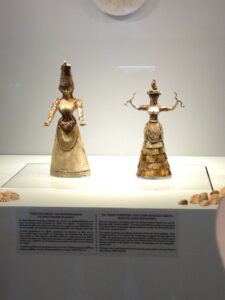
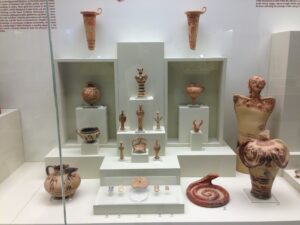
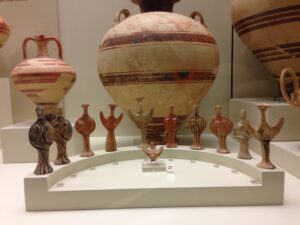
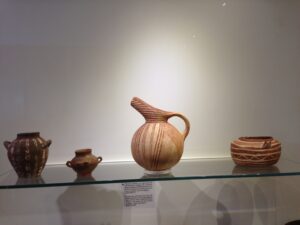
Finally, Fred took this candid photo of me walking through an ancient ruin, engaging in my favorite occupation, especially when traveling. I should look for that journal. It would be interesting to read it again.
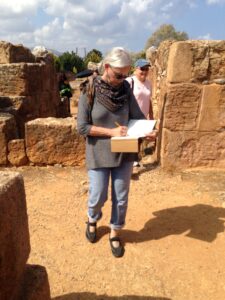
Image credit: Erechtheion with Original Paintwork Reconstruction, Mark Cartwright (CC BY-NC-SA)
Jean Raffa’s The Bridge to Wholeness and Dream Theatres of the Soul are at Amazon. Healing the Sacred Divide can be found at Amazon and Larson Publications, Inc. Jean’s new Nautilus Award-winning The Soul’s Twins, is at Amazon and Schiffer’s Red Feather Mind, Body, Spirit. Subscribe to her newsletter at www.jeanbenedictraffa.com.


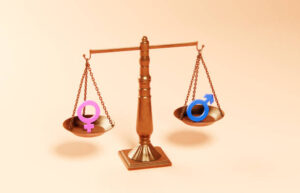

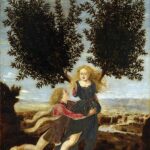
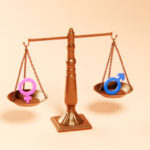
9 Responses
Dear Jeanie,
Thank you so much for populating my imagination with these wonderful ancient Greek statuettes and answering my question about what the Caryatids once carried in their broken arms. So many of these pieces felt like they truly belonged, especially those beautiful, queenly looking figures.
It’s been years and years since I’ve visited the British Museum in London, so thanks for the nudge there! In pure coincidence last Tuesday we visited an Aztec themed sculpture exhibition held at a local art museum. I loved exploring their incredible iconographic symbols and metaphors.
Two ancient civilisations in one week, both speaking directly to my thirsty soul! One I know more about, the ancient Greeks, the other, the ancient Aztecs, less so. Nevertheless, both seem closely intertwined somehow and no doubt have influenced each other. Oh, I love how the ancestors call!
Love and light,
Deborah
You’re welcome, Deborah. It was fun finding and going through those pictures. I also find the ancient Aztecs fascinating. Thank goodness for museums that do their best to preserve the relics of ancient civilizations. It’s fascinating to see the differences between them, but even more so, the similarities. The Nazca lines in Peru are one example. We flew over them some years ago in a small plane and saw the figure that looks like a person in a spacesuit! Much love, Jeanie
This is definitely a very comprehensive report for hungry mythology lovers (like me!). Many thanks, dear Jeane. Although, there is only one aspect that stuck out to me; as far as I know, the Persians were not there in that period, and it was a war between Athens and Sparta. Anyway, the Persians and Greeks have a lot more to offer.😉😅💖
Your comment about the Persians not being in Greece when the Erechtheum was constructed got me curious, so I looked it up. Here’s what I found:
“The first Persian invasion of Greece, during the Greco-Persian Wars, began in 492 BC, and ended with the decisive Athenian victory at the Battle of Marathon in 490 BC.”
Another source says:
“During this time, [The Golden Age of Greece] Ancient Greece had two very prominent city-states – Athens and Sparta. Often at war with one another, these two city-states had completely different ideologies. However, both were successful in their own way. They were both also instrumental in preventing the Persian Empire from conquering Greece. During the First Persian Invasion in 490 B.C., it was Athens that fought off a sizable Persian army using their phalanx style of fighting. During the Second Persian Invasion, both Sparta and Athens played their parts. For Sparta, it was during the Battle of Thermopylae where they were able to hold off the Persians long enough for the Athenian Navy to group together and form a battle strategy. The Athenian Navy bested the Persian Navy, and the Persians left, never to return again.”
So yes, Persians were not in Greece when the Erechtheum was constructed between 421 and 406. I wonder what would have happened if the Persians had won the Greco-Persion Wars. The Western world surely be very different if these two rich cultures had passed on their combined wisdom, knowledge, spiritual traditions, and art instead of evolving separately through the years as they did. Thanks for the food for thought! Jeanie
Thank you, my lovely, wise friend, for this worthy information. And yes! The famous battle of Marathon was decisive, and the Persians lost because of their pride and eagerness.🙏💖
This took me back Jeanie to our visit to Crete so many years ago. Son Mike and I are travelling to Europe mid-September and after some meandering (Paris, Prague, Italy) we plan to go to Greece and I would love to visit Crete again.
Your photos of these beautiful art works are lovely.
Some while ago, I had an urge to create a vessel which I did over a few weeks in my pottery class.
Love, Susan
What fun to be going to some of Europe’s most iconic destinations with your son. I hope you have a fabulous time. Thanks for writing, Jeanie
Fantastic. I love seeing these photos and imagining the possibilities. You make an excellent Caryatid, Jeanie. Fred must have noticed that. I’ve never been to Greece, so enjoyed all of this. With a bow to the Great Mother Goddess.
Hahaha. I never thought of that picture of me as a caryatid! But I was carrying what Deborah suggested suggested might be in the caryatids’ hands: writing material. Glad you enjoyed this. With a bow to the Great Mother Goddess, indeed. 🙂